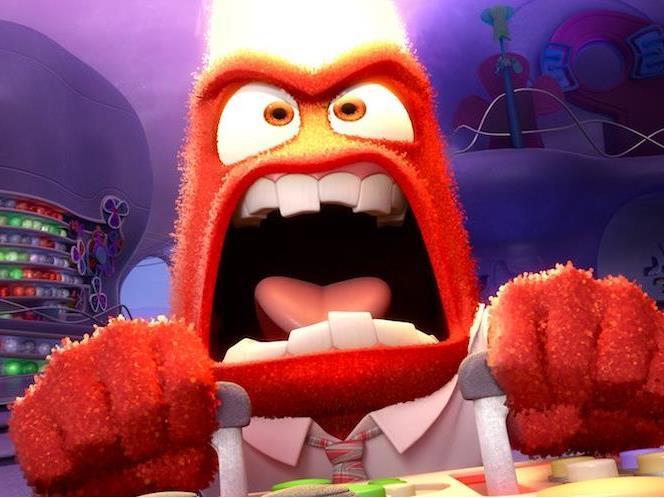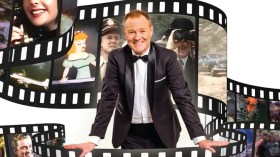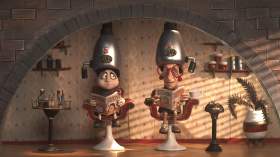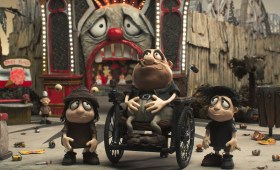Image: Pixar’s Inside Out. This looks a lot like Lawrence Levy at the start of his journey.
When Steve Jobs talked lawyer and Silicon Valley executive Lawrence Levy into becoming his Doppelganger as Chief Financial Officer of Pixar in 1994, the company was a shambles. It was originally set up by engineers to develop the fundamental technology of computer animation, and built wonderful tools which were so esoteric they had no market.
At the same time they doggedly continued to work on the production of an animated feature, Toy Story, which was nearly finished. But Pixar was haemorrhaging money, and Jobs was on the way to losing $50m at a time when he was the wandering guru sacked by Apple.
Levy has written a book, To Pixar and Beyond – my unlikely journey with Steve Jobs to make entertainment history. He spoke at Screen Forever 2017, where he turned out to be exquisitely practiced, superbly groomed and steeped in Buddhism.
He tells the ultimately bureaucratic story about an extraordinary achievement. Pixar has made eighteen features and never failed. It is the only major animation company which never hedged its bets with live action and theme parks.
Both Jobs and Levy were used to tech businesses, which rewarded the logical use of financial tools and market analysis. But entertainment is an intuitive gamble, selling dreams rather than processes. They walked together constantly, pacing out the miles, talking and listening, trying to work out what to do. They concluded that the Disney model did not really work for them because the live action industry was just as risky as animation. As Levy said in the plenary, ‘They are both terrible businesses and one terrible business is not going to offset the risk of another one so we might as well stick with the one we at least knew a little bit about.
‘Startups never have the luxury to hedge their bets. They never even have the resources to do the one thing that they want to do well. We had to go big and bet it all and the only piece of the business which had any upside was animated feature films. We had only one shot, but we had to take it.’
In 2017 Australian dollars Toy Story cost $65m to make and took $870m at the box office. Eleven years later they sold the company to Disney for nearly $10b. The one shot set the industry on fire.
Just before his plenary, I interviewed Levy in a corner. I took a deep breath and dived in.
What do you think is the core of Pixar’s identity?
‘I would think the core of Pixar’s identity is story. Pixar used to say that great graphics will keep an audience entertained for about two minutes. Great story keeps them in their seats for ninety. And that is a creed that Pixar really tried to live by.’
That is something any American producer will tell you. How are you different?
‘I think that is a really good question. I think Pixar took years and years to hone what it would take to really honour that story aspect. So the challenge with all the productions and creative endeavours is that you have these tensions that are pulling against each other. In Pixar’s case you have the story people trying to make a great story and you have the technical people and the business people, which is my side of it. And those things pull against each other.
‘What Pixar honed as well as anyone ever honed is the capacity to resolve those tensions without killing the creative spirit.’
What did that mean to you on the business side?
‘A couple of things. I’ll give you an example. One of the most fundamental decisions that any studio has to make is who has creative control over its output. And in many, many cases the executives of the company want to have the final say. They want to have creative control. And what Pixar did was reverse that.
‘We said we are going to give creative control to the creative people. Some people would say that is a crazy decision because when things go wrong creatively, the executives want to take over, step in and solve the problem. But Pixar didn’t do that. We really trusted the creative people and it worked.
‘Sometimes you have to take a really deep breath. When Andrew Stanton came to the executive team at Pixar and said I want to make a film about a robot, and by the way, its going to be a silent film and we need $150m to make it, we didn’t say “You are kidding me, we have to test this, we have to know, we can’t make a bet like that”. We said, “Okay, if the story team is behind it, you can do it.” ‘
You were operating as the head business person in that creative environment. How did that affect your daily life?
‘It meant that I call Pixar a talking company. A lot of business environments are top down environments where the executives at the top are issuing edicts and they are going down the company. But Pixar was a flat organisation. Everybody in order to get anything done at Pixar you had to talk to 25 people.
‘From an efficiency point of view, it’s terrible but from the point of view of really understanding information, knowing whats going on, its invaluable. An example of that would be something like how often do you make films? An animated feature film takes four to five years to make with two hundred people and there is no way to really shortcut that process. As a business person you are saying, wow you have to make films at least twice a year. All the spreadsheets, all the numbers, that is what they tell you.
‘But at Pixar we had this intense ongoing dialogue with the creative people to ask if that is possible, to see if we could make films that frequently without destroying the creative process. And you have to understand the creative process. So that is how Pixar worked, through this process of dialogue and collaboration.’
When you talk about understanding the creative process, how did you learn to do that?
‘Let me give you an example. As a business person you are saying, “Wow you have to make films at least twice a year. All the spreadsheets, all the numbers, that is what they tell you. I thought, “Let’s just shorten the process. Let’s just do it in three years.” How could it take so long? But five to six years later I was thinking I don’t even know how it is possible to make one of these films in four years.
‘The reason is I grew to understand the process of developing an original story. And I learned how you can’t force it, they have to mature. Its like a fine wine in a way and you can’t short cut that process. There isn’t a single film that Pixar made that didn’t run into terrible problems, with a moment when it ran off track or it was a disaster or we are never going to make it. You would think Pixar would have got better than that with each film, but it didn’t. And I learned that the reason it didn’t is because of how challenging it is to get story right and it takes time.
You are doing it all as an animatic first, aren’t you?
‘They are building it twice over because they first build it as a storyboard so it becomes four thousand images to tell the story of that film. Each of those images is generally redrawn five or six times. By the you get into the animation you may have draw – had drawn – thirty thousand images and then you get into.. 3D animation is an extremely expensive process so you do everything you can to not have to repeat it.’
What is it about animation that you think really draws people in?
‘Well, animation is a different type of art. In a live action film someone is seeing the sky and the trees and they are just in the background, which is what they are, generally speaking. In animation there are amazing artists, who have lovingly crafted every leaf. You have to make everything, the sky, the leaves, the trees, the water, the background. [speaking faster and faster] So the richness and depth of the imagery is extraordinary.
‘At least in Pixar’s case there are two things. One we take family entertainment very seriously. When Pixar says family entertainment it means entertainment for the whole family, not a children’s film that adults can take seeing. And secondly, Pixar did everything it could to make sure its films came from the hearts of the storytellers. There was no marketing to decide what was trendy or what was in or what people wanted. These were stories that were heartfelt by the people that were telling them. And I think that is one of its secrets.
Have you ever felt that the work Pixar is doing comes out of a kind of notions of human development?
‘Some. Nemo for example is a story about over-protective parents. Inside Out is the story of emotions and the mind, so in all of these things there is in-depth research happening to understand the human dynamics that are involved. Toy Story is obviously a buddy story.’
In-depth research?
‘It starts before a film even begins. In Finding Nemo they sent a team off for weeks to go and explore the elements of that film. It was set in Australia and so there was a team here exploring the Great Barrier Reef and really going into detail, making sketches, understanding the world they are going to create. Very detailed.’
So the process starts with a storyworld?
‘Yes. With a story idea. And then they go to understand that world. Pixar felt that we were going to create a completely immersive world but it has to be grounded in the world that you know so its not completely alien to you so there are always elements that you relate to.’
And those elements are elements about family dynamics?
‘Exactly. In Nemo’s case it was a story about fish but five minutes after the film started you forget it was fish and you were behind those characters. They have established a family and the loss of the mother.’
Like the characters in a Pixar film, Levy was connecting with creativity and evolving as a person. How did that play out?
‘I had my own movie to make, so to speak, and it was my passion for Eastern philosophy and meditation. And so I noticed that in corporate life there were a lot of hidden costs, high levels of stress and anxiety and low levels of meaning, low levels of self-worth. I wanted to understand what that was all about. I went off on another journey into Eastern philosophy. And I found a whole other world.’
He was a central figure in the sale of Pixar to Disney, which put Jobs on the board of the whole company. Levy said his work was done, and he withdrew from the corporate world.
‘Now my work is about bringing together these two worlds. I don’t believe that outer mastery, the expansion of the material world, is enough. It won’t solve all our problems unless you can marry it with inner mastery which is the expansion of the mind and the human spirit. Now I focus on that part after I focused on the first part.
‘I think this is what films do for us. They are signposts. I don’t mean the Hollywood superhero film. Like literature they point us to questions – where we are and where we are going if we are not careful, and where we could go if we get good at it.’
——
ACMI ran an excellent exhibition about the work methods of Pixar in 2007. The website explores the maquettes, storyboards and animatics, with an audio interview with artist and matte painter Paul Topolos.
——
While Levy’s practical insights about the relationship between creativity and business are valuable, animation delegates point to some basic rules behind Pixar’s success.
1. They really did make each film twice over, which is an extraordinary luxury.
2. Even though they worked slowly and burnt money, the financial side of the company always made sure there was enough money.
3. They always had huge studio releases via Disney.
4. Development is very slow and involves a huge amount of research, partly on the psychology of human development to underpin family and coming of age motifs.
5. They really do allow creatives to make mistakes, even though those mistakes are the most expensive ways to go wrong.
6. Pixar University enables staff to make short films.





